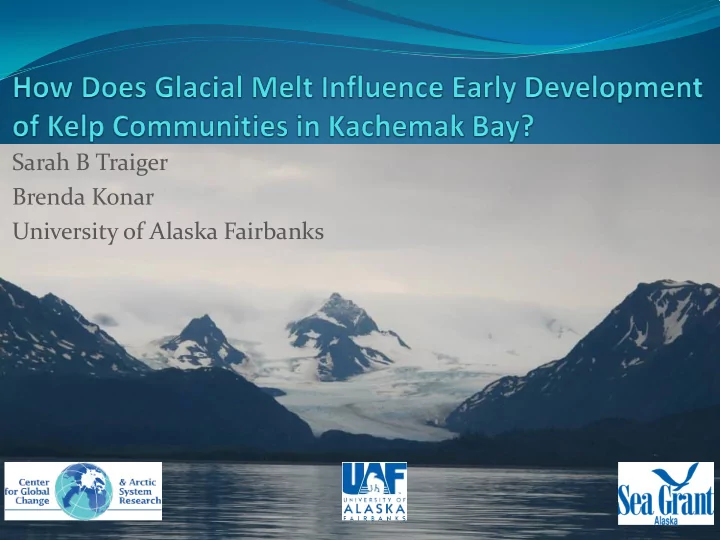

Sarah B Traiger Brenda Konar University of Alaska Fairbanks
Introduction Harding Icefield, lost 34 km 3 since 1950s Kachemak Glacier lost 16 m elevation (Adalgeirosdottir et al 1998) Glacial discharge changes environmental conditions nutrients, salinity sedimentation, light Negative effects on seaweed and sessile invertebrates Future changes Increase spatial extent of discharge Altered timing Increase discharge http://glacierhub.org/2014/07/28/scientists-find-yet-another-negative-impact-of-glacial-melt-ocean-acidification/
Introduction Kachemak Bay circulation Observed differences between inner Field & Walker 2003 and outer bay (Spurkland & Iken 2011) Outer bay has more diverse and higher abundance of kelp Only Saccharina latissima in inner bay Only one small population of Nereocystis luetkeana in inner bay
Introduction • Are these differences due to Recruitment = the appearance of new mortality over time or individuals differences in initial Succession = how community structure recruitment? changes over time Research Questions: 1. How does recruitment and succession vary across Kachemak Bay? 2. Are environmental factors correlated to patterns of recruitment and succession?
Methods Recruitment and Succession Environmental Variables In March 2013 placed 6 cleared rocks at April and biweekly throughout each site along 10 m depth contour summer 2013 & 2014 April and biweekly May-Sept 2013 & 2014 Counted all organisms and estimated Sedimentation rate percent cover on tops of each rock Temperature, Light, Salinity Nutrient Concentration
Results: Rock Community Community structure differed among sites PERMANOVA, p = 0.0001 Transform: Log(X+1) Resemblance: S17 Bray Curtis similarity SiteCode 2D Stress: 0.12 PG JB PB BC MC BB
Results: Kelp recruitment Kelp recruits (< 2 cm) 25 20 PG x/900 cm 2 PB 15 BC 10 MC BB 5 0 2013 2014 Kelp recruits (< 2 cm) 400 350 300 x/900 cm 2 250 200 JB 150 100 50 0 2013 2014
Results: Environmental Factors PERMANOVA , p = 0.003 Irradiance 45 40 35 30 Lum/ft 2 25 20 15 10 5 Southern-outer 0 Inner&Bishop's Central Inorganic Sedimentation rates 2013 2014 8 NH 4 7 Inorganic mg/cm 2 *d 5 6 4.5 4 5 3.5 3 4 µM 2.5 3 2 1.5 2 1 1 0.5 0 0 2013 2014 2013 2014
Results Environmental factors 2D Stress: 0.11 Transform: Log(X+1) explained 28% of variation in Resemblance: S17 Bray Curtis similarity SiteCode PG recruitment and succession JB (DistLM) PB BC MC BB NH 4 Temperature Temperature 14 PG 12 JB 10 PB 8 ° C BC 6 MC 4 BB 2 0 2013 2014
Summary
Summary Start Only 28% End
Conclusions Environmental factors don’t explain everything Other important factors? Kelp populations at glacially-influenced sites at risk to disturbance
Next Steps Time Series analyses Influence of mobile invertebrates and nearby kelp Quantify kelp microscopic stages across Kachemak Bay using genetics
Robert & Kathleen Acknowledgments Bryd Student Competition Volunteer divers: Katrin Iken Anne Benolkin Kasitsna Bay Lab: Committee Members: Lander Ver Hoef Alyssa Lind Mike Geagel Alexandra Ravelo Elizaveta Ershova Stephen Okkonen Hans Pedersen Kim Powell Martin Schuster Sarah Hardy Connie Geagle Richard Doering Ira Hardy Kris Holderied Eric Wood Shae Bowman
Recommend
More recommend